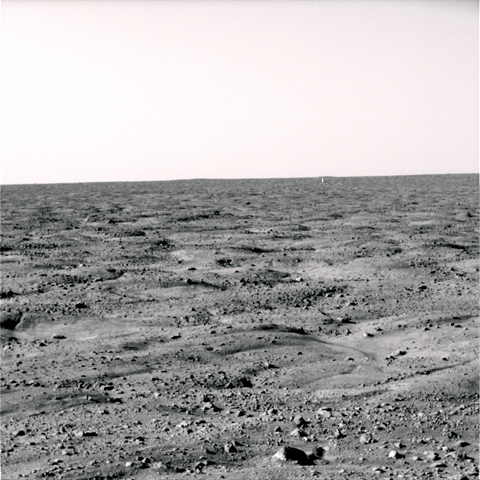NASA's Phoenix Mars lander spent its first full day in the Martian arctic plains checking its instruments in preparation for an ambitious digging mission to study whether the site could have once been habitable.
The three-legged lander set down on Sunday in relatively flat terrain covered by fissures outlining polygon shapes. The geometric cracks are likely caused by the repeated freezing and thawing of buried ice.
Images beamed back late on Monday showed the elbow joint of Phoenix’s trench-digging robotic arm still partly covered by a protective sheath. The sheath was supposed to fully unwrap after landing.

PHOTO: AP
Mission scientists downplayed the problem, saying they could still wiggle out the arm for digging.
“This is a minor inconvenience,” said Deborah Bass, deputy project scientist at NASA’s Jet Propulsion Laboratory in Pasadena. “We’re going to have to do a little bit of disentangling.”
It will be another week before Phoenix takes the first scoop of soil. After the initial taste test, the lander will spend the rest of the mission clawing through layers of soil to reach ice that is believed to be buried up to 30cm below the surface.
“We’ve only looked at one tiny little slit” of the landing site, said principal investigator Peter Smith of the University of Arizona, Tucson.
While Phoenix continued to dazzle scientists with scenes from the Martian high northern latitudes, one image that it returned of the sun came out bleeded. Instead of a point in the sky, the sun appeared like a light saber sword. Bass said engineers were working to fix the problem.
Mission co-scientist Ray Arvidson of Washington University in St. Louis is pleased with Phoenix’s progress so far.
“Like a union worker, it went right to work,” he said.
Scientists were especially interested in how the polygon patterns in the ground formed at Phoenix’s landing site. The fractures look similar to those found on Earth’s polar regions. Arvidson said Phoenix appeared within reach of a shallow trough that could be a potential place to dig.
“I was just afraid that it’ll be so flat and homogenous and that we’d be digging in soil and we wouldn’t know the context” of how it formed, Arvidson said.
Launched last summer, Phoenix sailed through 679 million kilometers of space over a period of about 10 months.
The riskiest part of the journey came seven minutes before landing, when Phoenix, operating on autopilot, had to use the atmosphere’s friction, deploy its parachute and fire its dozen thrusters to slow to a 8kph thump.
The lander executed the maneuver almost flawlessly. The only snag came when it released the parachute seven seconds later than expected. The late timing caused the spacecraft to land slightly down range from its intended target.
Two hours after touchdown, Phoenix beamed back a flood of images revealing the first ever peek of the polar horizon. It also sent back images of its unfolded heat shield and another of its foot planted in soil next to pebble-sized rocks.
Smith said Phoenix slid a bit after landing.
The US$420 million mission is led by the University of Arizona and managed by the Jet Propulsion Laboratory.

POLITICAL PRISONERS VS DEPORTEES: Venezuela’s prosecutor’s office slammed the call by El Salvador’s leader, accusing him of crimes against humanity Salvadoran President Nayib Bukele on Sunday proposed carrying out a prisoner swap with Venezuela, suggesting he would exchange Venezuelan deportees from the US his government has kept imprisoned for what he called “political prisoners” in Venezuela. In a post on X, directed at Venezuelan President Nicolas Maduro, Bukele listed off a number of family members of high-level opposition figures in Venezuela, journalists and activists detained during the South American government’s electoral crackdown last year. “The only reason they are imprisoned is for having opposed you and your electoral fraud,” he wrote to Maduro. “However, I want to propose a humanitarian agreement that

ECONOMIC WORRIES: The ruling PAP faces voters amid concerns that the city-state faces the possibility of a recession and job losses amid Washington’s tariffs Singapore yesterday finalized contestants for its general election on Saturday next week, with the ruling People’s Action Party (PAP) fielding 32 new candidates in the biggest refresh of the party that has ruled the city-state since independence in 1965. The move follows a pledge by Singaporean Prime Minister Lawrence Wong (黃循財), who took office last year and assumed the PAP leadership, to “bring in new blood, new ideas and new energy” to steer the country of 6 million people. His latest shake-up beats that of predecessors Lee Hsien Loong (李顯龍) and Goh Chok Tong (吳作棟), who replaced 24 and 11 politicians respectively

Young women standing idly around a park in Tokyo’s west suggest that a giant statue of Godzilla is not the only attraction for a record number of foreign tourists. Their faces lit by the cold glow of their phones, the women lining Okubo Park are evidence that sex tourism has developed as a dark flipside to the bustling Kabukicho nightlife district. Increasing numbers of foreign men are flocking to the area after seeing videos on social media. One of the women said that the area near Kabukicho, where Godzilla rumbles and belches smoke atop a cinema, has become a “real

‘WATER WARFARE’: A Pakistani official called India’s suspension of a 65-year-old treaty on the sharing of waters from the Indus River ‘a cowardly, illegal move’ Pakistan yesterday canceled visas for Indian nationals, closed its airspace for all Indian-owned or operated airlines, and suspended all trade with India, including to and from any third country. The retaliatory measures follow India’s decision to suspend visas for Pakistani nationals in the aftermath of a deadly attack by shooters in Kashmir that killed 26 people, mostly tourists. The rare attack on civilians shocked and outraged India and prompted calls for action against their country’s archenemy, Pakistan. New Delhi did not publicly produce evidence connecting the attack to its neighbor, but said it had “cross-border” links to Pakistan. Pakistan denied any connection to